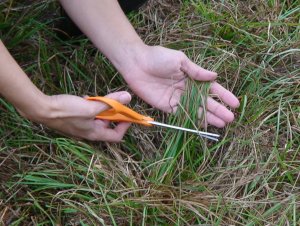Tissue Testing as a Management Tool to Predict P Fertilization Needs for Established Bahiagrass Pasture

Bahiagrass occupies a significant acreage in Florida and it is the primary forage for the cow-calf industry. Over the last decade, fertilizer recommendations for bahiagrass have been changed in order to address scientific, economic, and technological considerations of pasture fertilization. These changes included optimum soil pH levels, phosphorus fertilization and division of the State into north and south regions.
Tissue testing has been recently incorporated into fertilizer recommendations for bahiagrass pastures in Florida. The current UF/IFAS bahiagrass fertilizer recommendation includes both soil and tissue testing recommendations for established bahiagrass pastures. Information from both soil and tissue testing enables producers to better predict phosphorus requirements by bahiagrass pastures. While soil tests typically examine nutrient levels in the upper 6 inches of the soil profile, plant analysis can integrate the nutrient pools present at the various soil depths. Because of extensive plant root systems, plant analysis is believed to better assess the overall phosphorus status of forage crops than soil testing alone.
Similarly to soil sampling, collection and handling of tissue samples are crucial steps. The part of the plant to be sampled, maturity stage and time of sampling are also important factors that can affect plant nutrient composition. The number of plants to sample in a specific area will depend on the general conditions of plant vigor, soil heterogeneity, and forage management. A truly representative sample should be taken by sampling a large number of plants so that the sample represents the field. Collect at least 1 once (30 g) of fresh material. Sampling is not recommended when plants are injured by insects and diseases. To avoid contamination, plants should not be sampled soon after spraying pesticides or herbicides. Care should be taken to minimize soil contamination on the sampled plant material. In addition, plants should not be sampled under temperature or moisture stress. Preferably samples should be collected during a time of the day when climatic conditions are mild, generally early to mid-morning or early evening.
The four uppermost leaf blades should be sampled. Forage grasses and hay fields should be sampled prior to seed head emergence or at the optimum stage for forage utilization. After sampling, tissue should be placed in properly labeled paper bags and sent immediately to a reputable laboratory for analysis. Avoid plastic bags because they can hold heat and moisture. The same precautions used for collecting the plant material should be used to handle the samples. Because fresh plant material may start decomposing shortly after collection, it is important that plant material be sent to the laboratory as soon as possible. Prior to transporting the samples to the laboratory, plant material should be stored in a refrigerator at 41oF (or 5oC).

